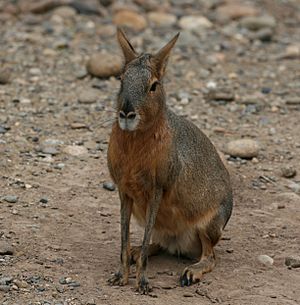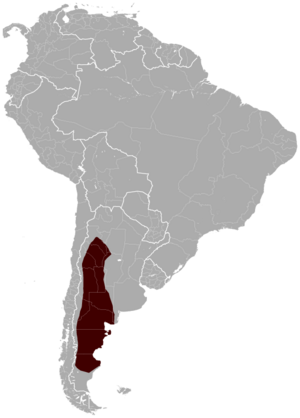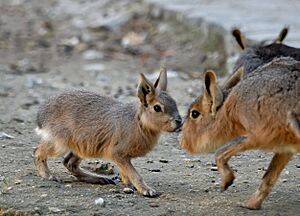Patagonian mara facts for kids
Quick facts for kids Patagonian maraTemporal range: Pleistocene - Recent
|
|
|---|---|
 |
|
| At Temaikèn Zoo, Argentina | |
| Conservation status | |
| Scientific classification | |
 |
|
| Patagonian mara range |
The Patagonian mara (Dolichotis patagonum) is a large rodent that looks a bit like a rabbit or a small deer. It's also known as the Patagonian cavy or Patagonian hare. These animals eat plants and live in open areas of Argentina, especially in a region called Patagonia. Some maras have also been seen in the northern United Arab Emirates. This might be because they escaped from homes or zoos. Patagonian maras usually stay with one partner for their whole lives. They often raise their babies together in shared underground homes called warrens.
Contents
What Does a Patagonian Mara Look Like?
The Patagonian mara looks a lot like a jackrabbit. It has long ears and long legs. Its back legs are stronger and longer than its front legs. This helps it run very fast. Its feet are shaped a bit like hooves. The front feet have four toes, and the back feet have three toes. Its tail is short and doesn't have much hair.
The mara's fur is gray on its back. It has a white patch on its rear, with a black area separating it from the gray fur. Its belly is white, and its sides and chin are a bit orange. An average Patagonian mara is about 69 to 75 centimeters (27 to 30 inches) long from head to body. Its tail is about 4 to 5 centimeters (1.6 to 2 inches) long. They usually weigh between 8 and 16 kilograms (18 to 35 pounds).
Where Patagonian Maras Live and What They Do
Patagonian maras only live in Argentina. They can be found from the northern parts all the way down to the south. They like places with bushes, but they can also live in dry, open areas. In some parts of Argentina, they live in forests or areas with creosote bushes. They especially like sandy areas with low bushes.
Maras are very good at running in open plains and grasslands. Their long legs, special bones, and good senses help them run fast and talk to each other in these wide-open spaces. When they run, they look a bit like deer or antelopes.
Maras mostly eat plants. They like green plants and fruits. In some desert areas, about 70% of their diet is grass, and 30% is other types of plants. They enjoy eating certain kinds of grass and plants like Atriplex lampa.
Maras are active during the day. They spend almost half their day looking for food. Their daily activities change with the weather. Light, rain, and temperature affect when they are active. Darkness and humidity make them less active. In winter, they are active once a day. In other seasons, they are active twice a day. They like temperatures around 20 degrees Celsius (68 degrees Fahrenheit).
Female maras spend more time eating than males. This is because they need more energy for having babies and feeding them. Males spend most of their day sitting and watching out for danger. Young maras are hunted by wild cats, grisons, foxes, and large birds of prey. Maras can also get tiny worms called parasites.
Social Life and How Maras Have Babies
Patagonian maras have a special way of living together. They are monogamous, meaning a male and female stay together for their whole lives. If one partner dies, the other might find a new one. The male mara usually follows the female everywhere to keep the pair together.
Mara pairs can have babies alone or with other pairs. They often share underground dens with up to 29 other pairs. In southern Argentina, maras have babies from August to January. A female mara is pregnant for about 100 days in the wild. Most babies are born between September and October. This is before the dry summer and after the winter rains. In the wild, females usually have one group of babies each year. But in zoos, they can have up to four groups a year. Baby maras can walk almost right after they are born!
During the breeding season, maras dig dens for their babies. Many pairs (from one to 22) group their babies together in these dens. Living together in a big group helps protect the babies from predators. Babies in larger groups have a better chance of surviving.
One pair of parents visits the den at a time, usually for about an hour. Other parents wait nearby. A female usually nurses one or two babies at a time. Sometimes, a female might even feed a baby that isn't hers. While some mothers try to stop other babies from drinking their milk, some clever babies manage to steal milk. Mothers don't actively help each other raise their young.
For the first three weeks, young maras stay close to the den. They spend a lot of time close together, cuddling, grooming each other, and playing. After three weeks, the young maras can leave the den and eat grass with their parents. They stop drinking milk from their mothers after about 13 weeks.
Maras make different sounds. When they want to find another mara, they make a "wheet" sound. When they follow another mara, they make a low, repeated grunt. If they feel threatened, they chatter their teeth and make low grunts. They also make short grunts when they are grooming themselves. Maras also use their scent to communicate with each other in important social situations.
Status of Patagonian Maras
The Patagonian mara is considered a "near threatened" species. This means they could become endangered in the future. In the past, maras lived across a large part of Argentina. However, hunting and changes to their habitat have caused their numbers to drop. They have even disappeared from some areas, like the Buenos Aires Province. People used to hunt maras for their skins to make things like bedspreads and rugs.
Images for kids
-
A Patagonian mara family in Southwick's Zoo - note pup nursing.
See also
 In Spanish: Dolichotis patagonum para niños
In Spanish: Dolichotis patagonum para niños







